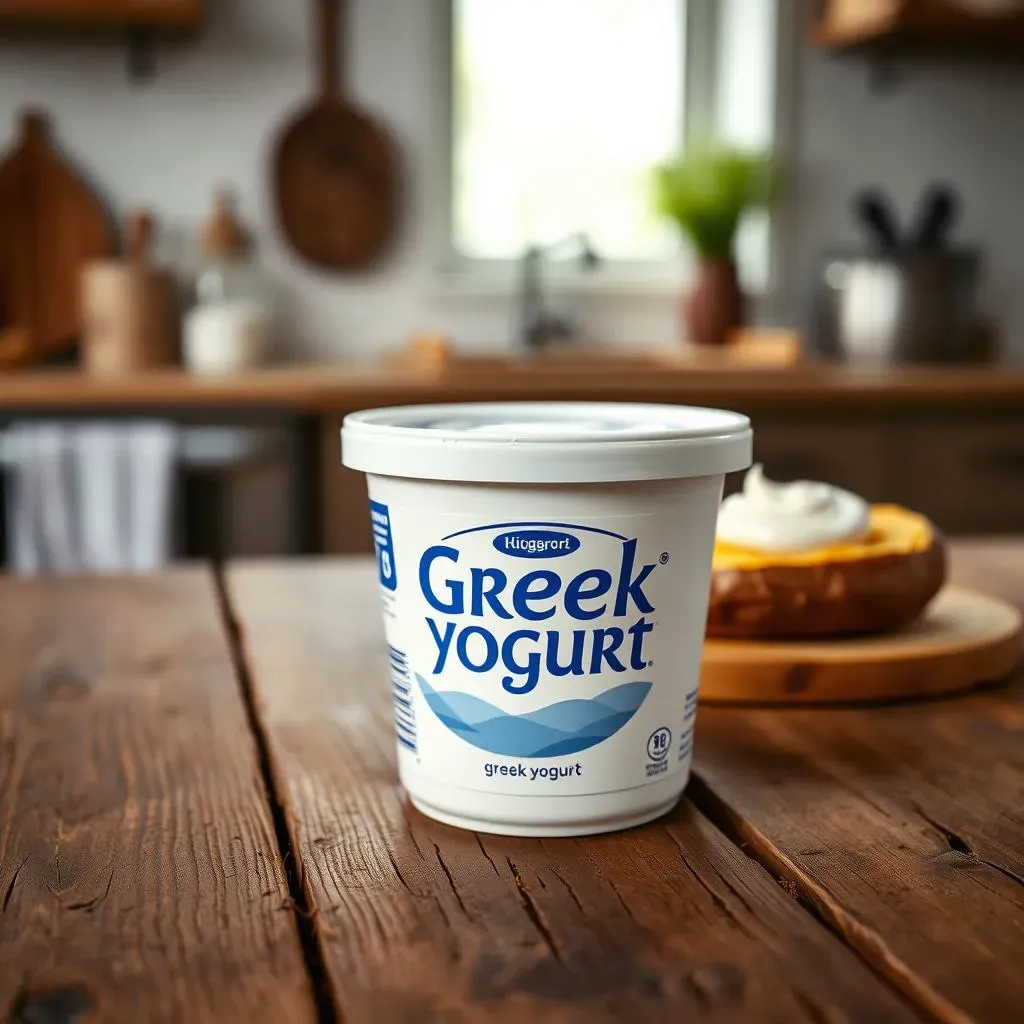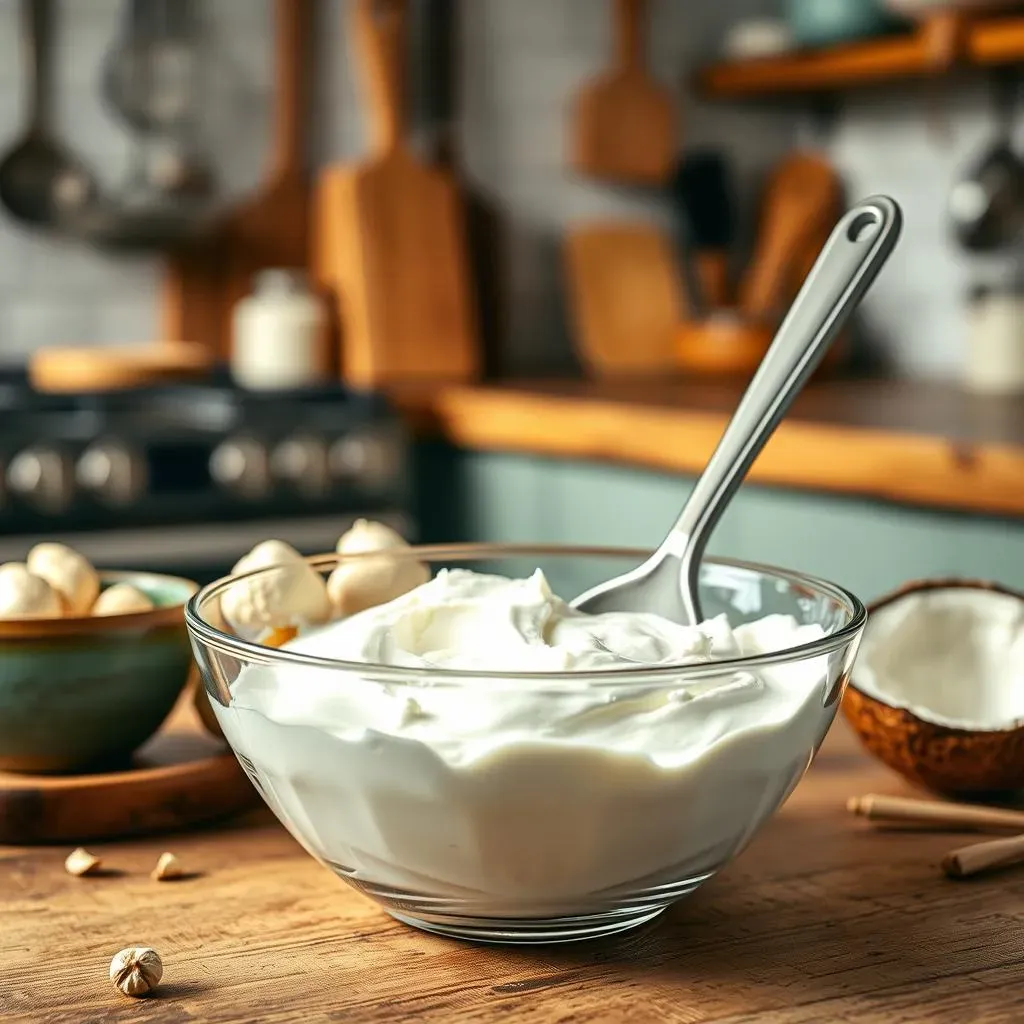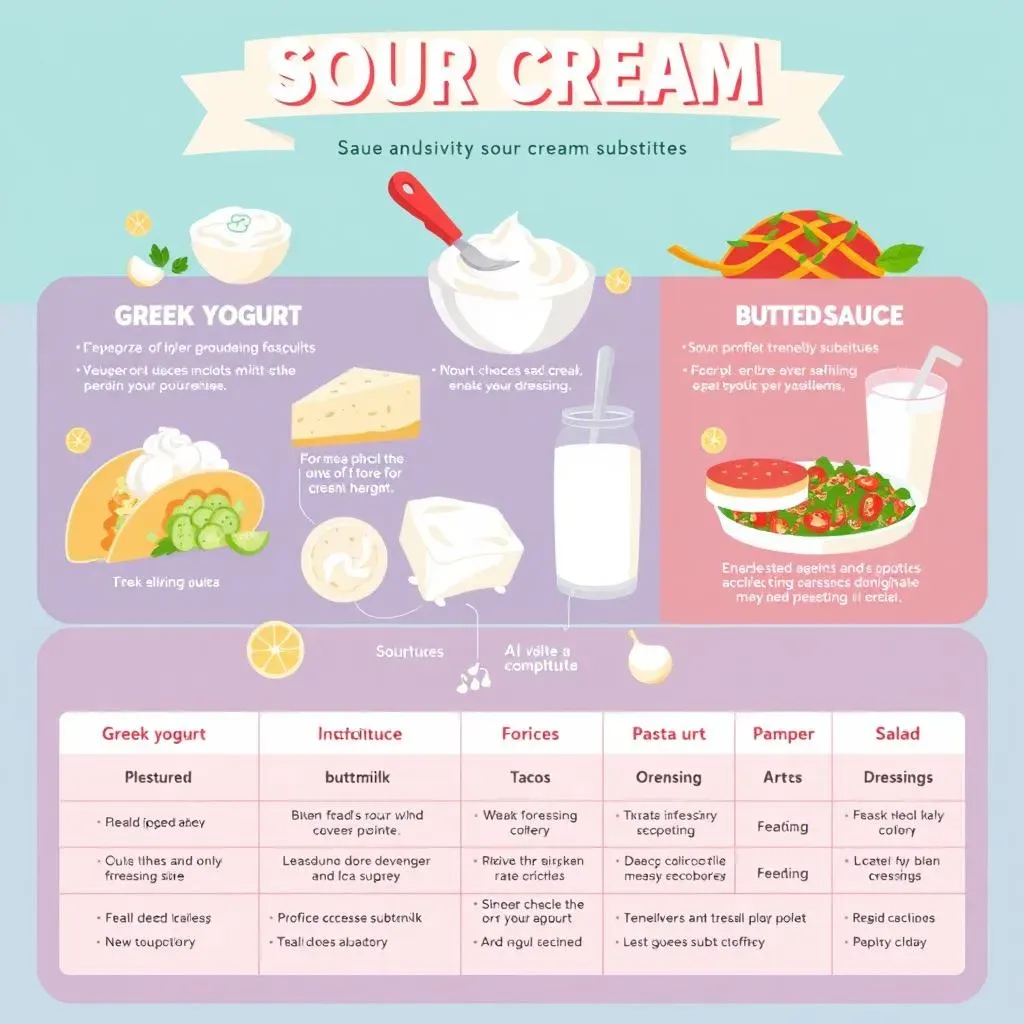Table of Contents
Ever found yourself mid-recipe, staring blankly into the fridge, realizing you're out of sour cream? It's a kitchen catastrophe many of us have faced. The good news is, there's no need to abandon ship or make a frantic grocery run. This article is your lifeboat, a guide to the wonderful world of the best sour cream substitute. We'll explore some common, and maybe some not-so-common, alternatives that can save your dish. From the tangy twist of Greek yogurt to the creamy richness of cream cheese, we'll cover a range of options. We will look into how to make your own, and which is the most suitable for your recipe. Get ready to discover the secret to keeping your cooking on track, even when the sour cream is MIA. So, let’s get started and find the perfect stand-in for your culinary needs.
Greek Yogurt: The Best AllAround Sour Cream Substitute

Greek Yogurt: The Best AllAround Sour Cream Substitute
The Tangy Truth About Greek Yogurt
Okay, let’s talk about Greek yogurt. It's like the superhero of the dairy aisle when you need a sour cream stand-in. This stuff isn't just for breakfast anymore; it's a real kitchen workhorse. I remember the first time I tried it, I was making tacos and totally spaced on getting sour cream. I had some Greek yogurt in the fridge and thought, "Why not?" It worked like a charm. It’s got that creamy texture and tangy flavor that makes it a great swap.
The magic behind Greek yogurt’s success is its thickness. It’s strained to remove the whey, which is the watery part, leaving you with a richer, denser product. This process gives it a texture that's super similar to sour cream, making it ideal for dolloping on your baked potatoes, mixing into dips, or even swirling into sauces. Plus, it’s packed with protein, a nice little bonus you don't get from regular sour cream.
How to use Greek Yogurt
You can use Greek yogurt pretty much one-to-one in most recipes that call for sour cream. It works great in both savory and sweet dishes. I’ve used it in everything from dips and dressings to cakes and muffins. Just be aware that it might be a bit tangier than sour cream, so you might want to adjust the other flavors in your recipe. For instance, if you're making a dip and it tastes a little too sharp, a pinch of sugar can balance it out.
Use Case | Notes |
|---|---|
Dips and Sauces | Great for creamy texture and tang. |
Baked Goods | Adds moisture and a slight tang. |
Toppings | Excellent on tacos, potatoes, and soups. |
A Few Things to Consider
Now, there are a couple of things to keep in mind. First, the fat content matters. Full-fat Greek yogurt will give you a texture that is closer to sour cream than the non-fat version. If you are trying to cut down on fat, non-fat works fine, but it might be a bit thinner. Second, if you are using it in a hot dish and you're worried about it curdling, try mixing it with a bit of cornstarch or flour before adding it to the hot ingredients. This will help stabilize it and prevent it from separating. So next time you are out of sour cream, don't fret, grab that Greek yogurt and get cooking!
Cream Cheese & Other Dairy Alternatives as Sour Cream Substitutes

Cream Cheese & Other Dairy Alternatives as Sour Cream Substitutes
Cream Cheese: The Rich and Decadent Option
Alright, let's move on to cream cheese, another contender in the sour cream substitute game. Now, cream cheese is definitely richer and denser than sour cream, so it's not always a perfect one-to-one swap. But, if you're looking for that creamy, decadent texture, cream cheese can be a real winner. I've used it in dips and sauces, and it adds a luxurious feel that's hard to beat. It's like the indulgent cousin of sour cream, bringing a touch of elegance to your dish. It's important to remember that cream cheese has a different flavor profile, it's less tangy, more mellow and buttery.
When using cream cheese, think about softening it first. Cold cream cheese can be a pain to mix smoothly. So, let it sit out for a bit or give it a quick zap in the microwave. Also, because it's so dense, you might need to thin it out a bit, especially if you're using it in a sauce or dressing. A splash of milk or some of the cooking liquid from your dish can do the trick. You will want to test it out and add it little by little until you get the desired consistency. If you are making a dip and you want a bit of tang, consider adding a touch of lemon juice or vinegar, which will help to mimic the flavor of sour cream.
Other Dairy Delights
Beyond Greek yogurt and cream cheese, there are other dairy options that can step in when sour cream is missing. Crème fraîche is a good example, it has a similar tangy flavor and rich texture, but it tends to be a bit more expensive. Another option is buttermilk, which is thinner than sour cream but can be a great substitute in baking or for sauces. Cottage cheese, when blended smooth, can also work; it's lighter than sour cream but still adds a nice creaminess. I've even heard of people using kefir, a fermented milk drink, as a substitute. It's all about experimenting and seeing what works best for your recipe. Each one of these options brings its own unique flavor and texture to the table. The best choice will depend on what you're making and what you have on hand.
When choosing a substitute, consider the overall flavor and texture you’re aiming for. If you’re making a light salad dressing, buttermilk or thinned-out cottage cheese might be your best bet. For something richer, like a creamy pasta sauce, cream cheese or crème fraîche could be the way to go. And remember, it’s okay to mix and match. Sometimes, a combination of substitutes can give you the perfect result. Maybe a mix of Greek yogurt and a touch of cream cheese. The possibilities are endless, so don’t be afraid to get creative and try some things out. It’s all part of the fun of cooking.
Dairy Substitute | Texture | Flavor | Best Use |
|---|---|---|---|
Crème Fraîche | Rich and creamy | Tangy, slightly nutty | Sauces, toppings |
Buttermilk | Thin and pourable | Tangy | Baking, dressings |
Cottage Cheese (Blended) | Smooth and light | Mild, slightly tangy | Dips, sauces |
Kefir | Thin and pourable | Tangy, slightly sour | Smoothies, dressings |
DIY Sour Cream and Unique Substitutes

DIY Sour Cream and Unique Substitutes
DIY Sour Cream: Taking Matters Into Your Own Hands
Okay, so you're feeling adventurous? Let's talk about making your own sour cream. It’s not as daunting as it sounds, I promise. The basic idea is to take something creamy, like heavy cream or milk, and add an acid to make it thicken and get that tangy flavor. A simple version involves mixing heavy cream with lemon juice or white vinegar. You let it sit at room temperature for a bit, and boom, you've got a homemade sour cream of sorts. It won’t be exactly the same as store-bought, but it’s a pretty good stand-in. I like it because you can control the level of tang by adjusting the amount of acid you add.
There are other variations too. Some people use a culture, like buttermilk or kefir, to ferment the cream. This takes a bit longer, but it gives you a more authentic sour cream flavor. I once tried making it with kefir, and it was surprisingly good. It was a fun experiment, and I felt like a mad scientist in my kitchen. The texture was super creamy, and the flavor had a great depth. It's all about trying different methods and seeing what works best for your taste and schedule. If you are into the more hands-on approach, this is for you, and it lets you experiment with different base liquids, and different acids.
Unique Substitutes: Thinking Outside the Dairy Aisle
Now, let's get a little wild. What if you're not into dairy at all? No problem, there are some pretty cool non-dairy options out there. Silken tofu, for example, can be blended to a smooth, creamy texture. It doesn’t have the same tang as sour cream, but you can fix that with a bit of lemon juice or vinegar. I've seen people use cashews too. You soak them, blend them, and you get a rich, creamy base that's perfect for dips and sauces. It's pretty amazing what you can do with some nuts and a good blender.
Another interesting option is using a mix of coconut cream and lemon juice. It’s a great substitute if you are looking for something vegan and it has a nice, rich flavor. It's not exactly the same, but it’s a good alternative. The key is to experiment and find what you like. Don't be afraid to try unusual things, that's how you discover new favorites. It’s also a good way to cater to dietary restrictions and preferences. Whether you're vegan, lactose intolerant, or just trying to switch things up, there are plenty of options to keep your cooking interesting.
Substitute | Base | How to use |
|---|---|---|
DIY Sour Cream (Cream & Acid) | Heavy cream or milk | Mix with lemon juice or vinegar and let sit |
DIY Sour Cream (Cultured) | Heavy cream or milk | Mix with buttermilk or kefir and let ferment |
Silken Tofu | Silken tofu | Blend until smooth, add lemon juice or vinegar |
Cashew Cream | Cashews | Soak, blend, and add lemon juice |
Coconut Cream | Coconut Cream | Mix with lemon juice |
Choosing the Best Sour Cream Substitute for Your Recipe

Choosing the Best Sour Cream Substitute for Your Recipe
Understanding Your Recipe's Needs
Alright, so we've covered a bunch of sour cream substitutes, but how do you pick the right one? It really boils down to understanding what your recipe needs. Are you looking for tanginess? Creaminess? Or both? For instance, if you're making a dip where that signature sour cream tang is crucial, Greek yogurt is likely your best bet. Its flavor profile is the closest to the real deal. But, if you are making a rich cake, you might lean towards cream cheese or even a mix of cream cheese and Greek yogurt for moisture and richness. It’s about matching the substitute to the role sour cream plays in your dish.
Think about the texture too. If you need something pourable, like for a dressing or a drizzle, buttermilk or thinned-out yogurt might be the way to go. If you are looking for something thick and sturdy, cream cheese or a full-fat Greek yogurt would be the better choice. I always start by asking myself, "What is the main purpose of the sour cream in this recipe?" Is it for flavor, texture, or both? Once you have this figured out, the right substitute becomes much clearer. It's like picking the right tool for the job; using a hammer to drive a screw is not going to work. Similarly, using the wrong substitute can mess up your final dish.
Considering Flavor Profiles
Next, you have to think about the flavor. Some substitutes are more neutral, while others have a distinct taste. Cream cheese is milder than sour cream, while Greek yogurt is tangier. If you're using something like silken tofu or cashew cream, you'll need to add some acid, like lemon juice or vinegar, to get that signature sour cream tang. It's all about balancing the flavors. I always taste as I go. I will add a bit of the substitute, taste, and adjust the other ingredients to make sure everything works together nicely. Taste often, and do not be afraid to make changes as you go.
Also, think about the other ingredients in your recipe. If you’re making a dish that’s already pretty tangy, you might want to choose a milder substitute. For instance, if you're making a dish with lots of citrus, you might want to avoid using Greek yogurt, which is also tangy. On the other hand, if the dish is very rich and heavy, the tang of the Greek yogurt can help to cut through it and make it less cloying. It’s a balancing act, and it takes a bit of practice to get it right. Don't be afraid to experiment and make mistakes. It's all part of the learning process.
Recipe | Best Substitute | Why |
|---|---|---|
Tacos or Baked Potatoes | Greek Yogurt | Tangy and creamy, similar texture |
Creamy Pasta Sauce | Cream Cheese or Crème Fraîche | Rich, decadent texture |
Salad Dressing | Buttermilk or Thinned Yogurt | Thin and pourable |
Vegan Dip | Silken Tofu or Cashew Cream | Dairy-free, creamy base |
Test and Adjust
Finally, always test and adjust. Cooking is not a science, it’s an art. Don’t be afraid to try something new or to modify the recipe. Start with a small amount of your chosen substitute, taste, and add more if needed. If you find that the substitute is too thick, you can thin it with a little milk or water. If it's too thin, you can try adding a bit of cornstarch or flour to thicken it up. It's always a good idea to start with less and add more, as you can always add more, but it's much harder to take it out. I like to say that cooking is a constant process of tweaking and adjusting until you get the result that you want.
Also, do not be afraid to mix and match substitutes. Sometimes, a combination of two or more will give you the best result. For example, a mix of Greek yogurt and cream cheese can give you the perfect balance of tang and richness. The key is to have fun with it and don’t be afraid to experiment. You might just stumble upon your new favorite kitchen hack. Ultimately, the best sour cream substitute is the one that works best for you and your recipe. So, get in the kitchen, try a few things out, and see what happens! You might be surprised by how many great alternatives are out there.